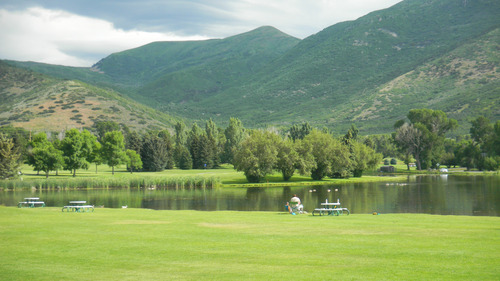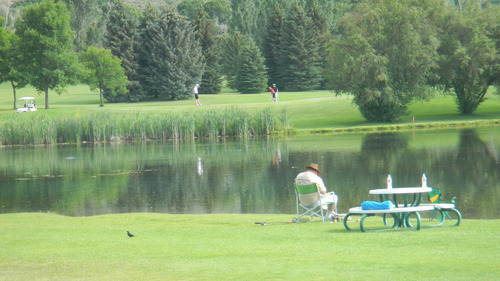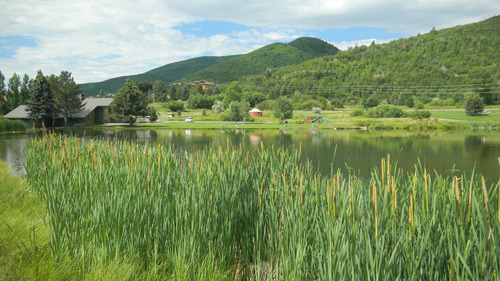This is an archived article that was published on sltrib.com in 2011, and information in the article may be outdated. It is provided only for personal research purposes and may not be reprinted.
Midway • In the late 1950s and early 1960s, the Utah State Parks Commission began the process of purchasing thousands of acres of private land in the Heber Valley for what would become Wasatch Mountain State Park.
In a 1960 editorial in the Deseret News, then-Utah Gov. George Clyde supported spending $1.35 million to purchase much of the 24,000 acres that now encompasses Utah's most popular state park.
"What value would there be to the public today if Zions and Bryce and the Grand Canyon and any number of other such wonders had been surrounded by honky-tonks or by private estates from which the public was barred," wrote Clyde. "What man today even considers the original dollar cost of protecting and developing those areas, compared to their priceless value today?
"These questions are germane to the announcement this week that the Utah Park and Recreation Commission is prepared to acquire immediately the heart of the proposed Wasatch Mountain State Park and will ask the Legislature to appropriate funds to acquire the rest," continued Clyde.
"Every indication is that future generations will have as much reason to be thankful for the vision that preserved that magnificent area for the public as the present generation has for those who preserved Yellowstone and Grand Canyon and Bryce and Zion and the rest."
Fast forward 50 years and that vision for Wasatch Mountain State park seems to be a reality. Combine rounds of golf played at Soldier Hollow and Wasatch Mountain's 72 holes of golf, camping, hiking, off-highway vehicle riding, cross country skiing, fishing, picnicking and snowmobiling and the park on the Wasatch back hosts over 360,000 visitors a year.
Its golf courses are recognized locally and nationally as some of the best public facilities in the country.
Though the aging campground's spots are often too small and lack the needed amenities for modern recreation vehicles and many of its picnic tables and roads look worn out, spots fill quickly during the summer.
A mix of locals and out-of-state tourists flock to the park, generating close to $16 million a year for the local economy.
Layne Billings, of Lehi, joined his parents, Ron and Dawn, from Iowa on a recent outing. He said just getting away from the city was wonderful. He and his family used their site as a base camp to visit the Mirror Lake area as well as more urban destinations.
"It's very important," said Daniel Robison, of Heber City, as he fished in a small pond next to the visitors center. "This is a good place close where we can spend time together, bring out the kids and go fishing. We have come here and fished a few times. I have no complaints."
Park manager Bruce Strom does, however, hear the occasional gripes, mostly from RV owners who can't fit their units into spots constructed in the 1960s or from those who say the hookups don't have the right amps.
"The sites were built in 1967," he said. "They are narrow and short."
Roads in the campground show heavy signs of wear as well. Many are patched. Some picnic tables have been replaced, but there are a number of older wooden tables that are badly warped. Some look barely usable.
An emphasis on running state parks more like a business than a public park facility after a January legislative performance audit has changed the way park managers such as Strom look at spending slim resources.
For example, a number of trails for hikers, bikers and horseback riders have been built over the years. Strom had other plans for such trails, but all are now on hold.
"Trails don't make money," he said. "We have to focus on things that make money like golf, camping and new group sites, not putting money into trails. That is not well spent. That is not my job. We had a trail planned from the campground to the clubhouse, but that's a money pit. Our mission has changed. Instead of providing services the public doesn't have to pay for, it's how do I make money? If it's not revenue attached, we are not going to look at doing that."
According to the legislative audit, Wasatch Mountain's visitors require a $1.99 per visitor subsidy. Soldier Hollow golfers require $5.30 a round from funds other than golf fees. Only the 36-hole Wasatch golf course makes money, turning a $3.57 profit for the 94,623 rounds played there.
Yet, judging from the amount of use Utah's most popular state park receives, Clyde and the Legislature that used tax dollars to purchase private land for Wasatch Mountain seem to have helped not only preserve a state park but also helped fuel development of the surrounding area.
History of Wasatch Mountain State Park
Key dates in Wasatch Mountain State Park history
Deer Creek campground's first 17 units opens in 1964.
The Chalet opens for group use in 1964.
The Wasatch golf course opens for play on June 20, 1967. It expanded to 27 holes in 1972 and to 36 holes in the late 1990s.
The visitor center, including exhibits and displays, was completed in 1968 and renovated in 2003.
The Pine Creek Campground with the Oak Hollow and Cottonwood units was completed in 1967.
The Mahogany campground was completed in 1977, with the amphitheater added in the mid 1980s.
An extensive non-motorized trail system at Dutch Hollow was developed in 2002.
Soldier Hollow was utilized for the cross-country skiing and biathlon portions of the 2002 Winter Olympics and remains in use as a training center and winter recreation area.
The 36-hole Soldier Hollow Golf Course opened for play in July of 2004.
Source: History of Midway and Wasatch Mountain State Park













